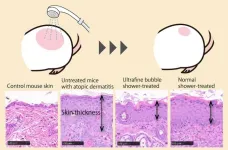(Press-News.org) At the center of most large galaxies, including our own Milky Way, sits a supermassive black hole. Interstellar gas periodically falls into the orbit of these bottomless pits, switching the black hole into active galactic nucleus (AGN)-mode, blasting high-energy radiation across the galaxy.
It's not an environment you'd expect a plant or animal to thrive in. But in a surprising new study in the Astrophysical Journal, researchers at Dartmouth and the University of Exeter show that AGN radiation can have a paradoxically nurturing effect on life. Rather than doom a species to oblivion, it can help ensure its success.
The study may be the first to concretely measure, via computer simulations, how an AGN's ultraviolet radiation can transform a planet's atmosphere to help or hinder life. Consistent with studies looking at the effects of solar radiation, the researchers found that the benefits—or harms—depend on how close the planet is to the source of the radiation, and whether life has already gained a toehold.
"Once life exists, and has oxygenated the atmosphere, the radiation becomes less devastating and possibly even a good thing," says the study's lead author, Kendall Sippy, who graduated from Dartmouth last year. "Once that bridge is crossed, the planet becomes more resilient to UV radiation and protected from potential extinction events."
The researchers simulated the effects of AGN radiation on not only Earth, but Earth-like planets of varying atmospheric composition. If oxygen was already present, they found, the radiation would set off chemical reactions causing the planet's protective ozone layer to grow. The more oxygenated the atmosphere, the greater the effect.
High-energy light reacts readily with oxygen, splitting the molecule into single atoms that recombine to form ozone. As ozone builds up in the upper atmosphere, it deflects more and more dangerous radiation back into space. Earth owes its favorable climate to a similar process that happened about 2 billion years ago with the first oxygen-producing microbes.
Radiation from the sun helped Earth's fledgling life oxygenate, and add ozone, to the atmosphere. As our planet's protective ozone blanket thickened, it allowed life to flourish, producing more oxygen, and yet more ozone. Under the Gaia hypothesis, these beneficial feedback loops allowed complex life to emerge.
"If life can quickly oxygenate a planet's atmosphere, ozone can help regulate the atmosphere to favor the conditions life needs to grow," says study co-author Jake Eager-Nash, a postdoctoral fellow at the University of Victoria. "Without a climate-regulating feedback mechanisms, life may die out fast."
Earth, in real life, is not close enough to its resident black hole, Sagittarius A, to feel its effects, even in AGN-mode. But the researchers wanted to see what could happen if Earth were much closer to a hypothetical AGN, and thus exposed to radiation billions of times greater.
Recreating Earth's oxygen-free atmosphere in the Archean, they found that the radiation would all but preclude life from developing. But as oxygen levels rose, nearing modern levels, Earth's ozone layer would grow and shield the ground below from dangerous radiation.
"With modern oxygen levels, this would take a few days, which would hopefully mean that life could survive," Eager-Nash says. "We were surprised by how quickly ozone levels would respond."
When they looked at what could happen on an Earth-like planet in an older galaxy with stars clustered closer to its AGN, they found a much different picture. In a "red nugget relic" galaxy like NGC 1277, the effects would be lethal. Stars in more massive galaxies with an elliptical shape, like Messier-87, or our spiral Milky Way, are spread out more, and thus, farther from an AGN's dangerous radiation.
The stars align aboard the Queen Mary 2
Sippy came to Dartmouth with a keen interest in black holes, and by the end of second term, had joined the lab of study co-author Ryan Hickox, professor and chair of physics and astronomy. Later, while debating a potential senior project on AGN radiation, fate intervened.
Heading to England for a sabbatical in 2023, Hickox booked a trip on the Queen Mary 2 so he could bring his dog, Benjamin. Aboard the ship, he got to chatting with an astrophysicist from Exeter, Nathan Mayne, who was a guest speaker on the ship. They quickly realized they had a mutual interest in radiation, and that the PALEO software Mayne had been using to model solar radiation on exoplanet atmospheres could be applied to the more powerful rays of an AGN.
The encounter would clear the way for Sippy to work with Eager-Nash, then a PhD student in Mayne's lab. Using the programing language Julia, they input into their model the initial concentrations of oxygen, and other atmospheric gases, on their Earth-like planet.
"It models every chemical reaction that could take place," says Sippy. "It returns plots of how much radiation is hitting the surface at different wavelengths, and the concentration of each gas in your model atmosphere, at different points in time."
The feedback loop they discovered in an oxygenated atmosphere was unexpected. "Our collaborators don't work on black hole radiation so they were unfamiliar with the spectrum of a black hole and how much brighter an AGN could get than a star depending how close you are to it," says Hickox.
Without the kismet that brought the two labs together, the project might never have happened. "It's the kind of insight you can only really get by combining different sets of expertise," he adds.
After graduating from Dartmouth, Sippy left for Middlebury College, to work as a post-baccalaureate researcher in the lab of McKinley Brumback, who worked in Hickox's lab as a PhD student and is now an assistant professor of physics at Middlebury studying accreting neutron star X-ray binaries.
She brought a unique perspective to the project. In the X-ray binaries that she studies, a neutron star pulls matter from a normal star, causing in-falling material to heat up and emit X-rays.
While an AGN can take up to millions of years to flip between active and inactive states, X-ray binaries can change in mere days to months. "A lot of the same physics that applies to AGNs applies to X-ray binaries, but the time scales are much faster than for an AGN," she says.
Brumback contributed to the AGN analysis and served as a "slightly removed reader" to make sure the paper was accessible to non-experts, she says.
"Thanks to Kendall's excellent writing, it definitely was!"
END
How black holes could nurture life
A new study co-led by Dartmouth researchers shows how radiation from black holes could have a nurturing effect on life.
2025-03-21
ELSE PRESS RELEASES FROM THIS DATE:
Dr. Amit Bar-Or, penn medicine neuroimmunologist, awarded the 2025 John Dystel prize for multiple sclerosis research
2025-03-21
Amit Bar-Or, MD, a distinguished researcher and neurologist at Penn Medicine, is the winner of the 2025 John Dystel Prize for Multiple Sclerosis Research, awarded jointly by the National Multiple Sclerosis Society and the American Academy of Neurology. He is being honored for advancing our knowledge of neuroimmunology, precision medicine, and biomarkers in MS. Dr. Bar-Or will deliver the Dystel Prize lecture and receive his award at the American Academy of Neurology 2025 Annual Meeting in San Diego, California on April 8, 2025.
“Dr. Bar-Or has been a key player in shaping the evolving conceptual framework of MS, including how the ...
Recent study in mice provides key insights on the impact of excessive sucrose consumption in specific organs
2025-03-21
Researchers at the Advanced Research Unit on Metabolism, Development & Aging (ARUMDA), in the Tata Institute of Fundamental Research (TIFR, Mumbai and TIFR Hyderabad), have unveiled a comprehensive understanding of the harmful effects of sugar-sweetened beverages (SSBs) on human health, using a preclinical mouse model that closely mimics human consumption patterns. The study, published in the Journal of Nutritional Biochemistry, sheds light on how chronic sucrose-water intake (10%) alters key physiological, molecular, and metabolic processes across various organs, driving ...
A less toxic way to manufacture daily goods
2025-03-21
Diisocyanates are used in the preparation of all polyurethanes, ranging from the foams used in shoe soles to the thermoplastics used in cell phone cases. Aromatic diisocyanates, which give polyurethane foams their structure, are commonly prepared on the megaton scale in highly secure facilities due to the use of phosgene, a highly reactive and toxic chemical reagent. Michael Burkart’s lab at UC San Diego recently reported the preparation of fully bio-based aromatic diisocyanates from a simple monosaccharide, D-galactose. This new route avoids the use of transition metals, gaseous reagents or any high-pressure/temperature reactions. As an application, the team demonstrates ...
Nearly half of depression diagnoses could be considered treatment-resistant
2025-03-21
Almost half of patients diagnosed with depression classify as being ‘treatment-resistant’ as new research suggests that many don’t respond to multiple antidepressant options.
The new study, published in the British Journal of Psychiatry was led by academics from the University of Birmingham and Birmingham and Solihull Mental Health NHS Foundation Trust. The study found that 48% of patients whose electronic healthcare records reported a diagnosis of depression had tried at least two antidepressants, and 37% had tried four or more different options.
Treatment-resistant depression (TRD) is ...
Deadly bacteria developed the ability to produce antimicrobials and wiped-out competitors
2025-03-21
A drug-resistant type of bacteria that has adapted to health care settings evolved in the past several years to weaponize an antimicrobial genetic tool, eliminating its cousins and replacing them as the dominate strain. University of Pittsburgh School of Medicine scientists made the discovery when combing through local hospital data – and then confirmed that it was a global phenomenon.
The finding, published today in Nature Microbiology, may be the impetus for new approaches in developing therapeutics against some of the world’s deadliest bacteria. It also validates a new use for a system developed at Pitt and UPMC that couples genomic sequencing ...
Device enables direct communication among multiple quantum processors
2025-03-21
Quantum computers have the potential to solve complex problems that would be impossible for the most powerful classical supercomputer to crack.
Just like a classical computer has separate, yet interconnected, components that must work together, such as a memory chip and a CPU on a motherboard, a quantum computer will need to communicate quantum information between multiple processors.
Current architectures used to interconnect superconducting quantum processors are “point-to-point” in connectivity, meaning they require a series of transfers between network nodes, with compounding error rates.
On the way ...
Nanotech-induced cooling improves crop yields in arid climates
2025-03-21
Scientists at King Abdullah University of Science and Technology (KAUST) have developed and combined a new nanoplastic and biodegradable mulch to passively cool greenhouses in hot, arid climates like those in the Middle East. Applying their technology, they lowered temperatures of miniature greenhouses by 25 degrees Celsius and increased crop yields of Chinese cabbage by nearly 200%. The study can be read in Nexus.
The nanoplastic consists of polyethylene, the most widely produced plastic in the world, infused with nanoparticles consisting of the molecule cesium tungsten oxide. These nanoparticles absorb ...
Home sweet home: some great hammerhead sharks stick to the perfect neighborhood in the Bahamas instead of migrating
2025-03-21
New research shows that some great hammerhead sharks are homebodies. Scientists studying great hammerheads around Andros in the Bahamas shark sanctuary have found that while some individuals migrate, others prefer to stay at home — potentially because their environment provides them with everything they need. This information could help protect the critically endangered species.
“The global population of great hammerheads is thought to have reduced by more than 80% over the last three generations, and genomic ...
Bubbly idea: Ultrafine bubble showers suppress atopic dermatitis
2025-03-21
Bubble baths might be soothing soaks, but bubble showers could be the next thing in keeping the skin clean.
An Osaka Metropolitan University-led medical research team found that ultrafine bubble showers might help prevent atopic dermatitis.
Graduate School of Medicine student Ayaki Matsumoto and Associate Professor Hisayoshi Imanishi led the study into using ultrafine bubbles, often used to clean medical equipment, on mice with atopic dermatitis.
The scientists found that in mice with atopic dermatitis due to external factors, inflammation was markedly suppressed when the affected skin ...
Aotearoa once home to elephant seals
2025-03-21
Southern elephant seals are the “canary in the coal mine” for the Southern Ocean, offering insight into how the ecosystem may react to future climate change and human impact, new research shows.
Joint senior author Associate Professor Nic Rawlence, Director of the Otago Palaeogenetics Laboratory, says while elephant seals now only inhabit the subantarctic islands and South America, Aotearoa beaches used to be “heaving” with the colossal animals.
“At the time of human arrival in New Zealand, you would be hard pressed to find room on the beaches, with fur seals on the rocky headlands, prehistoric sealions and elephant seals ...
LAST 30 PRESS RELEASES:
When is it time to jump? The boiling frog problem of AI use in physics education
Twitter data reveals partisan divide in understanding why pollen season's getting worse
AI is quick but risky for updating old software
Revolutionizing biosecurity: new multi-omics framework to transform invasive species management
From ancient herb to modern medicine: new review unveils the multi-targeted healing potential of Borago officinalis
Building a global scientific community: Biological Diversity Journal announces dual recruitment of Editorial Board and Youth Editorial Board members
Microbes that break down antibiotics help protect ecosystems under drug pollution
Smart biochar that remembers pollutants offers a new way to clean water and recycle biomass
Rice genes matter more than domestication in shaping plant microbiomes
Ticking time bomb: Some farmers report as many as 70 tick encounters over a 6-month period
Turning garden and crop waste into plastics
Scientists discover ‘platypus galaxies’ in the early universe
Seeing thyroid cancer in a new light: when AI meets label-free imaging in the operating room
Neutrophil-to-lymphocyte ratio may aid risk stratification in depressive disorder
2026 Seismological Society of America Annual Meeting
AI-powered ECG analysis offers promising path for early detection of chronic obstructive pulmonary disease, says Mount Sinai researchers
GIMM uncovers flaws in lab-grown heart cells and paves the way for improved treatments
Cracking the evolutionary code of sleep
Medications could help the aging brain cope with surgery, memory impairment
Back pain linked to worse sleep years later in men over 65, according to study
CDC urges ‘shared decision-making’ on some childhood vaccines; many unclear about what that means
New research finds that an ‘equal treatment’ approach to economic opportunity advertising can backfire
Researchers create shape-shifting, self-navigating microparticles
Science army mobilizes to map US soil microbiome
Researchers develop new tools to turn grain crops into biosensors
Do supervised consumption sites bring increased crime? Study suggests that’s a myth
New mass spec innovation could transform research
Maternal nativity, race, and ethnicity and infant mortality in the US
Migration-related trauma among asylum seekers exposed to the migrant protection protocols
Jupiter’s moon Europa has a seafloor that may be quiet and lifeless
[Press-News.org] How black holes could nurture lifeA new study co-led by Dartmouth researchers shows how radiation from black holes could have a nurturing effect on life.




